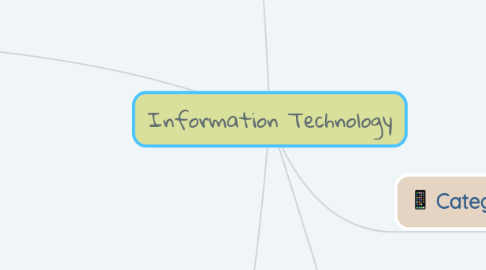
1. Advantages of Information Technology
1.1. Globalization
1.2. Effective Communication
1.3. Cost Effective
1.4. More convenient to shop
1.5. Creation of new jobs
2. Definition: The use of computer hardware and software to store, retrieve, and manipulate information.
3. Disadvantages of Information Technology
3.1. Unemployment
3.2. Privacy
3.3. Cyber sickness
3.4. Dominant culture
4. Application of Information Tecgnology
4.1. Education
4.1.1. Educators and teaching institutions use technology to assist with education.
4.2. Science
4.2.1. All branches of science use computers to assist with collecting, analyzing, and modeling data.
4.3. Travel
4.3.1. We can reserve car, hotel and flight by using websites
4.4. Finance
4.4.1. Many people and companies use computers to help manage their finances.
4.5. Government
4.5.1. Most government offices have Websites to provide citizens with up-to-date information.
4.6. Healthcare
4.6.1. The medical staffs around us are using computers for various purposes.
4.7. Manufacturing
4.7.1. The use of computer to assist with manufacturing processes.
4.8. Publishing
4.8.1. Many publishers of books, magazines, newspapers, music, film and video make their work available online.
5. Categories of Computers
5.1. Supercomputers
5.1.1. The fastest, most powerful and most expensive computer that is capable of processing many trillions of instructions in a single second.Supercomputers generally run one program at a time, as fast as possible.
5.1.2. Applications requiring complex, sophisticated mathematical calculations use supercomputers.
5.2. Mainframes
5.2.1. A large, expensive, powerful computer that can handle hundreds or thousands of connected users simultaneously. Capable of great processing speeds and data storage.
5.2.2. Run multiple applications simultaneously to serve a variety of users.
5.2.3. Enterprises are able to bill millions of customers, prepare payroll for thousands of employees, and manage thousands of items in inventory.
5.2.4. They are measured in MIPS (million instructions per second) and respond to up to 100s of millions of users at a time.
5.3. Personal computers
5.3.1. Is a computer that can perform all of its input, processing, output, and storage activities by itself. A personal computer contains a processor, memory, and one or more input, output, and storage devices.
5.3.1.1. Desktop
5.3.1.2. Notebook
5.3.2. Personal computers also often contain a communications device.
5.4. Embedded Computers
5.4.1. An embedded computer is a special-purpose computer that functions as a component in a larger product.
5.4.2. Embedded computers are everywhere - at home, in your car, and at work.
5.5. Mobile Computers and Devices
5.5.1. Mobile Computers is a portable personal computer, designed so that a user easily can carry it from place to place
5.5.2. Mobile Device Computing device small enough for a user to hold in his or her hand.
